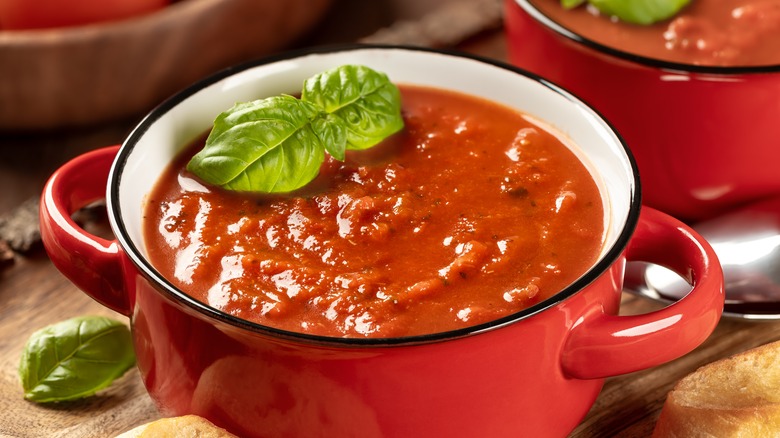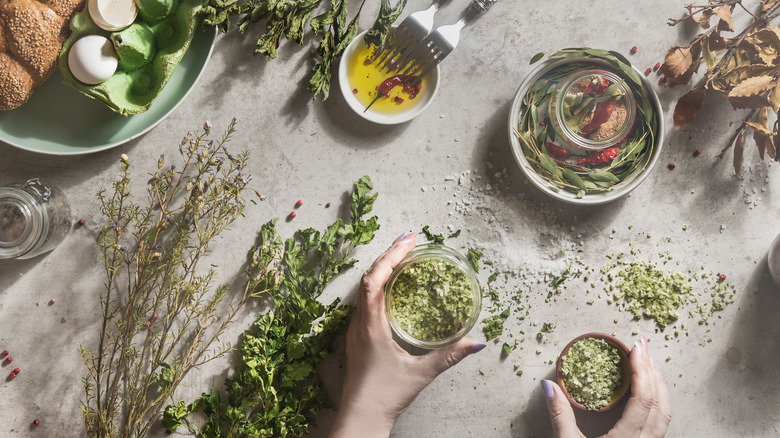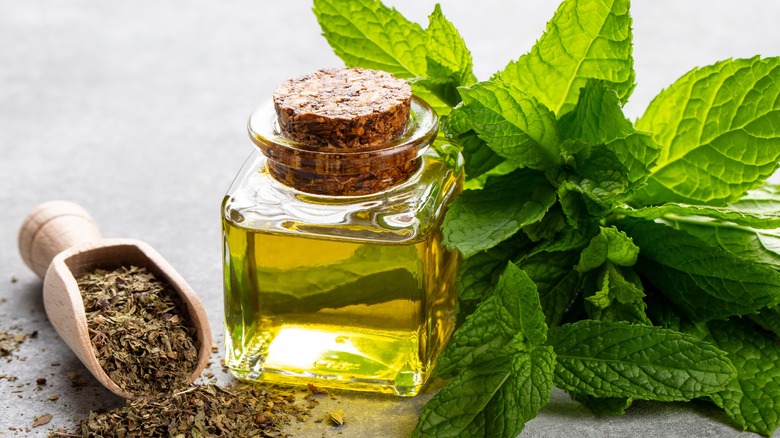The Last Guide You'll Ever Need For Cooking With Basil
Basil is an extremely useful herb. When fresh, it offers a lemony zing to salads, curries, and cheese. When dried, it is wonderful in sauces, soups, pasta, and a wide variety of other foods. There's a reason it has been used as a flavoring agent since ancient times, not to mention as a medicinal herb in Chinese and other traditional practices.
Its healthy herbal properties aside, basil is just plain delicious. Using it well is, however, a matter of education. Too much basil can be grassy and overwhelming, whereas the flavor can be lost amidst other strong ingredient profiles if you're not careful. Plus, fresh basil is delicate and can quickly lose its essential oils if overcooked or not used in a timely manner.
If you're looking for a greater understanding of when to apply basil fresh or dried, in what quantity, how to source it, how to prepare and grow it, how to substitute for it, and so on, then you've come to the right place. Welcome to Basil 101.
What is basil?
Basil (Ocimum basilicum) is an herb in the mint family (Lamiaceae). Although sweet basil is the default, there are other varieties of basil commonly used in cooking, including holy basil (O. tenuiflorum) and Thai basil (O. basilicum var. thyrsiflora). It grows as an annual in temperate climates but may grow as a perennial in some places where there is no chance of frost, as the plant is highly sensitive to cold. The plant is widely grown in kitchen gardens around the world, and its leaves are used in cooking and medicine.
Basil is a leafy, sometimes leggy, herb whose leaves grow in alternating patterns up stems that can reach two feet tall. Healthy basil will bush out significantly, sometimes reaching two feet wide as well. It puts out beautiful magenta flowers starting in early summer and will keep producing them, like its leaves, until the first frost.
A brief history of basil
Although its genetic roots are no doubt far older, basil's use as a cooking herb originated between 4,000 and 5,000 years ago. Although many folks associate it with Italian or otherwise Mediterranean cooking, it's actually native to India, hence its strong associations with Thai cooking and other cuisines from Southeast Asia. Some sources say it also has roots in parts of Africa.
Whatever the case, it was a widespread culinary and medicinal herb by the time of the Ancient Greeks and Romans, and also used as an embalming agent in Ancient Egypt. The Greeks, who were apparently huge fans of it, called it basileus phuton, which means "kingly herb." Other ancient sources also call it basilikon phuton, which may be related to the fact that it was supposed to cure snakebites and protect one against the basilisk. (Which, unless you're Harry Potter, seems unlikely.) Holy basil was strongly associated with Hindu mythology, and the goddess Tulasi or Tulsi supposedly took the form of a basil plant when she incarnated on Earth.
From the ancient world, basil moved through the Middle Ages (where some doctors thought it poisonous), then to Britain, North America, and finally the rest of the world. Today, it is a mainstay of Italian soups and sauces and a critical flavoring agent in Southeast Asian cooking, but also pops up in many other cuisines as well.
The flavor of basil
Basil is a fascinating herb because it combines the flavors of so many other seasonings into one effortless package. When you first bite into a basil leaf, you'll notice a spicy bite like you get from black pepper. Over time, though, the taste mellows into something much sweeter (hence the common name of basil's most popular incarnation: sweet basil). Flavors of mint and anise also come into play. The larger the leaves get, the more of that spicy flavor you will notice with basil.
Other varieties of basil have different, though related, flavor profiles. For instance, Thai basil has serious licorice tones and maintains its flavor better during cooking. Holy basil is spicier than common sweet basil, while lemon basil's obvious flavor profile becomes more pronounced when you mince or cook it. Opal basil is mild and cinnamon-like, while purple basil is strong enough to stand up to meat dishes. All of which is to say, you've got options.
Available forms of basil
Beyond the differences in basil varieties, basil comes in many forms, the main three preparations being fresh, dried, and living. The latter are sold in pots that you can either continue to grow on your counter or put in the ground outside. Even in climates that get cold in the winter, potted basil will usually grow as an annual until the first frost, putting out new stalks and leaves when you pinch off mature ones.
Fresh basil is found in the herb section at most grocery stores, sitting next to its cousins mint, thyme, sage, and so forth. Dried basil is located in the spice aisle, either crumbled in a jar or, sometimes, as whole dried leaves. These are harder to find, though, and you might have to look online. Lastly, almost any decent grocery store will carry jarred pesto, which makes for an easy dip or pasta topping on a busy weeknight.
How to choose the best herbs
Choosing the best herbs varies by the form in which you're buying them. If you are buying fresh or living basil, make sure it stands up straight when held upright. If it's droopy, that means it's been too long without water and is already wilting. It likely won't hold up until you get it home and may look sad in whatever dish you're cooking.
If dried, look for herbs that are green and within their best-by date. It's okay if they're a bit olive-colored or dark, but they shouldn't be straight-up brown or gray. Choosing ethically sourced and produced herbs is better for people and local ecosystems, and it is definitely better for the Earth because the food hasn't traveled as far. Believe it or not, a full 5% of a food's carbon footprint comes from transportation, so if you can get herbs from nearby, you can reduce that.
Common uses for basil in the kitchen
Basil is classically used as a flavoring agent for soups and sauces. It adds peppery zing to pasta and pizza sauce, and it is delicious when mixed into Mediterranean salads containing tomatoes, cheese, and olives. You can use it to flavor shrimp kebabs, sliced tomatoes, and mayonnaise with equally awesome results.
Basil is perhaps at its finest blended into pesto, a magical combination of cheese and oil and nuts, perfect for quickly topping noodles, spreading on bruschetta, or serving as a dipping sauce for bread. If you love sauces but want to move beyond Italian cuisine, try a basil salsa verde, which goes well with Mexican dishes and is a simple combination of parsley, capers, chives, oil, and lemon.
Plus, the fresh leaves can elevate anything from avocado toast to crispy Thai beef. Indeed, basil is often used as a garnish, and it's frankly great at its job.
Basil: World's tastiest garnish
In addition to adding great flavor to a variety of dishes, basil is a wonderful garnish. It works for soups, salads, and pasta dishes, among others. The perpendicular leaves that grow along its stems create an almost floral effect when you put sprigs at the side of a one-pot meal or a charcuterie board. At the same time, individually picked leaves, which lay flat, go perfectly on top of Caprese salad or pizza.
On bruschetta, pasta, or salads, ribbons of basil look lovely. For that reason, it's always worthwhile to learn to chiffonade it, otherwise known as Gordon Ramsay's stacking technique. To do so, first stack individual leaves together, placing them inside one another like little bowls (basil leaves all have a distinct curvature). Then roll up the stacked leaves into a small tube, holding it firmly without squishing it. Use a sharp knife to slice the tube into narrow strips, around ⅛ inch at the widest. It is critical you use a super sharp knife, as a dull one will bruise the leaves too much during cutting.
Once you have your strips, carefully unroll them from one another and sprinkle them over your dish. If the dish is hot, do this right before serving, as the heat will cook the basil and make it look dull and sad. Even if using them on a fresh dish, add them at the very last minute, as basil will quickly brown at the edges.
Basil in drinks and desserts
Basil is excellent as a flavoring for dessert. Because it blends so well with citrus, especially lemon, you'll often find it as a sorbet or ice cream at upscale restaurants or ice creameries with an eccentric side. But they're also not hard to recreate at home. For instance, basil ice cream and lemon basil sorbet are two lovely, summery recipes you might want to try at home. The dessert-y goodness doesn't end there, either. You might want to try lemon basil cookies with white chocolate chips and pistachios or limoncello basil cake, both of them are showstoppers at the end of a meal. Basically, if you've got lots of fresh herbs to use up, the internet has your back when it comes to recipes.
You can also turn basil into cooling cocktails for a warm evening, such as a bourbon and basil sidecar or a lemon basil martini. Remember when using fresh basil that it helps to abuse it lightly to release its oils, which is why mixologists sometimes smack herbs before putting them in a cocktail or using them as a garnish. You'll notice an immediately heightened aroma when you do so. You needn't confine yourself to the bar when using basil, either; it's a great addition to virgin drinks such as elevated lemonade.
When to use fresh versus dried basil
While the exact form and amount will differ by recipe, in general, you should aim to use fresh basil in recipes that don't call for cooking and dried basil in cooked recipes. The more powerful flavor of dried basil helps it come through in dishes where there are a lot of ingredients or that use heat for long periods of time, whereas the delicate flavor of just-picked herbs stands out in recipes where fewer, fresher foods are featured. You can use fresh basil in cooked recipes, of course, but make sure to add it at the end as mentioned previously.
If you are using dried herbs in a recipe, it's important to note that the leaves lose some of their flavor in drying, and the remaining oils (which contain the aromatic compounds) are buried deeper within. Accordingly, when adding dried basil to your recipes, you should first rub it between your hands to break it up further, helping to release those oils and flavor your dishes more effectively.
How to substitute for basil
The ideal option if you need a certain type of basil but don't have any on hand is to use another form of it. For instance, you could use Thai basil in a salad that calls for sweet basil, bearing in mind that its flavor is more intense and peppery. Or you could use sweet basil in a curry, but you might need to throw in a little more of it.
Another useful tip is to substitute dried herbs for fresh, or vice versa, but always do it in the right ratios. Generally, you'll be safe with a 3:1 ratio of fresh to dried, e.g. one tablespoon of fresh chopped basil to one teaspoon of dried crumbled leaves. If you don't have plain basil at all, try a dried blend that contains it, such as Italian seasoning.
Cousins in the mint family are the next best choice when you need to substitute a different herb for basil. Think oregano, tarragon, and thyme, all of which will lend that peppery, herbal, sweet note to your dishes. Herbs outside the mint family, such as cilantro, can also work. Indeed, it can even be fun to try different herbal substitutions in classic favorites. For instance, you might try swapping mint out for basil in a mojito.
Growing your own basil
Basil is an easygoing plant that loves hot, sunny spots and will thrive all summer long. You can either start seeds indoors yourself, sow them outside, or buy basil starts at the nursery. This writer has found the last strategy to be by far the most reliable, especially with somewhat iffy soil, but you can take your pick. As long as you give basil well-drained soil and enough water, it will grow happily.
Once basil starts producing leaves of a size you can reasonably cook with, you can begin to harvest them. Remove basil stems right above leaf nodes (places in the stem where leaves emerge). This will encourage your plant to produce more stems and leaves over the months to come. If your basil starts to bolt, which means to produce flowers, you can pinch the blooms off. This will keep your plant bushy and continuing to produce fragrant green leaves. However, note that you can eat the flowers in salads and stir-fry recipes, so get creative!
Drying basil at home
If you grow your own basil, you may find yourself with a surplus at the end of the summer. In that case, you might benefit from learning to dry it yourself. Happily, this is a relatively easy proposition for which you can choose one of several avenues: hanging, dehydrating, or microwaving. All are simple once you get the hang of them and will leave you with delicious dried basil all year long.
The most common and time-honored way to dry basil is to hang it. First, harvest it, remembering to pinch stems off right above leaf nodes. If you are buying your bunch at the store, you can obviously skip this step. Next, tie the basil with string or kitchen twine, then hang them upside down, ideally near a window where they'll get good light and airflow. This helps evaporate moisture quickly to reduce spoilage.
If you only have leaves, you can use the oven trick. This involves leaving them at room temperature for a few days and then drying them on a sheet pan in the oven at 170 degrees Fahrenheit until they crumble easily in your hands, typically about an hour and a half. You can also place them in the dehydrator set to "herbs," or arrange them in a single layer on a paper towel and put them in the microwave on low, cooking in one-minute bursts until dry and crunchy.
Health benefits of basil
Basil is not only tasty, it's great for your cardiovascular system, blood sugar, and many other bodily functions. Studies indicate it may also help boost your mood, improve stress, and make you think more clearly. What better reason to make Caprese salad more often?
Among the many antioxidants present in basil leaves (depending on species) are eugenol, limonene, beta-carotene, and various anthocyanins, which can help stave off cancer, arthritis, and diabetes as well as heart disease.
Do note that while basil maintains a lot of its flavor and aroma when dried, many of its most potent health benefits do not survive desiccation. As such, if you're looking to increase your longevity and amp up your health, choose fresh basil whenever possible.
Storing basil to last
Storing a fresh herb such as basil poses a challenge to many a modern cook, because it is delicate by nature, even when properly handled. The best way to keep it good for longer is to wash it to remove germs and dirt, both of which can contribute to more rapid spoiling. You should remove browned or slimy leaves before doing so. After washing, make sure to run it through the salad spinner to prevent the herbs from getting soggy, which can also lead to spoilage. Use a light towel, such as linen, to remove any leftover water, and let it fully dry on the counter.
Next, form basil stalks into a bunch and trim the bases, then place the bunch in a jar with ½ inch of water at the bottom, so that the leaves will not touch it and spoil faster. Note that although many herbs do well using the bouquet method in the fridge, you should place basil on the counter. To make it last as long as possible, pop a plastic bag over the top of it until you're ready to use it.
Nutritional information
Basil might just win the 'Has Calories But You'd Never Know It' game, weighing in at a whopping one calorie per two tablespoons. It contains vanishing amounts of fat, cholesterol, sugar, and sodium, and a teeny amount of protein. As such, you can't count on basil for any macronutrients, meaning it will always be a flavoring agent and garnish rather than a real staple (not that you'd want to eat more than a tablespoon or two anyway).
However, basil leaves have lots of water and plenty of trace nutrients. It contains decent levels of Vitamins A and K, as well as calcium, iron, and manganese. Indeed, those deficient in Vitamin K would do well to add a bit more dried basil to their diets, as a tablespoon contains 43% of the recommended daily intake. Other than that, you shouldn't rely on basil to provide any real quantity of vitamins and minerals, with the caveat that most seasonings do contribute in small ways to your overall health.















